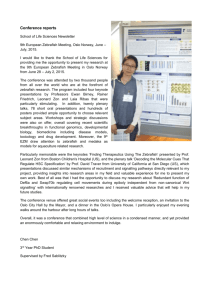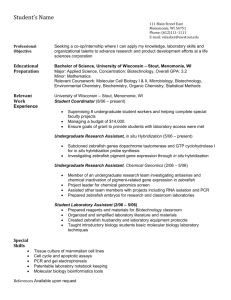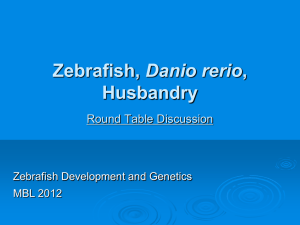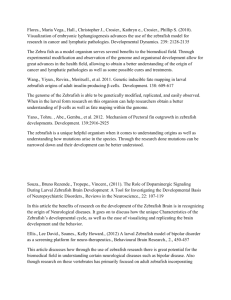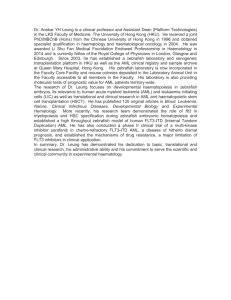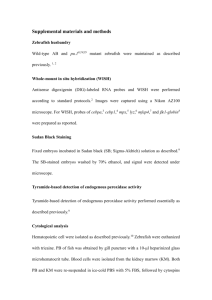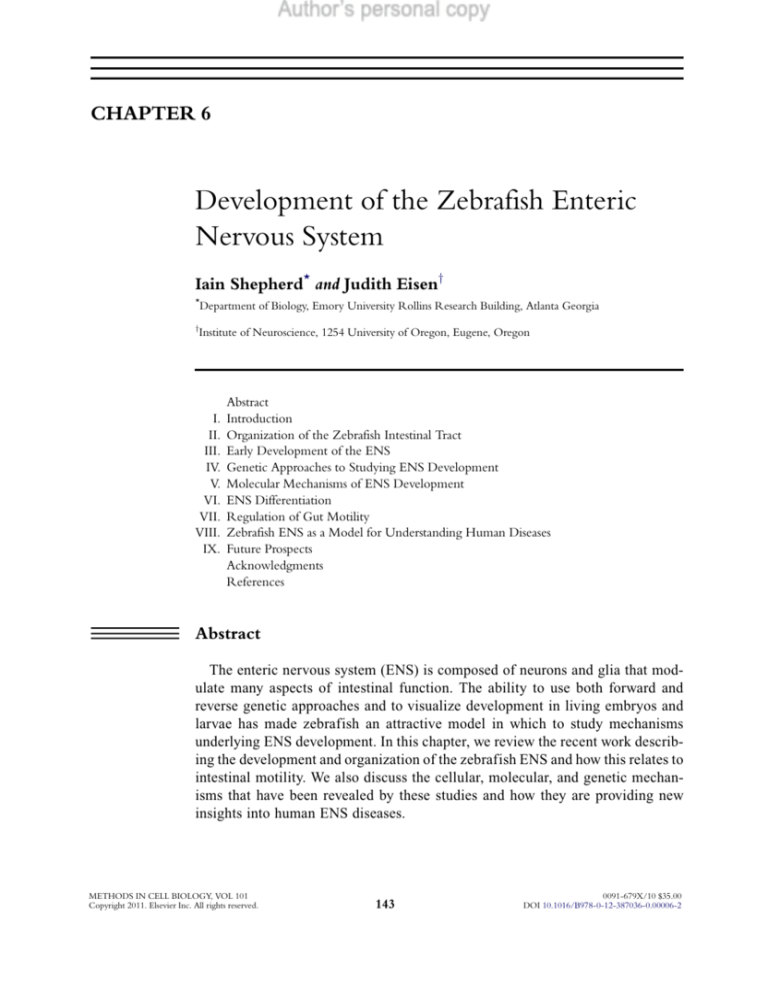
CHAPTER 6
Development of the Zebrafish Enteric
Nervous System
Iain Shepherd* and Judith Eiseny
*
y
Department of Biology, Emory University Rollins Research Building, Atlanta Georgia
Institute of Neuroscience, 1254 University of Oregon, Eugene, Oregon
I.
II.
III.
IV.
V.
VI.
VII.
VIII.
IX.
Abstract
Introduction
Organization of the Zebrafish Intestinal Tract
Early Development of the ENS
Genetic Approaches to Studying ENS Development
Molecular Mechanisms of ENS Development
ENS Differentiation
Regulation of Gut Motility
Zebrafish ENS as a Model for Understanding Human Diseases
Future Prospects
Acknowledgments
References
Abstract
The enteric nervous system (ENS) is composed of neurons and glia that modulate many aspects of intestinal function. The ability to use both forward and
reverse genetic approaches and to visualize development in living embryos and
larvae has made zebrafish an attractive model in which to study mechanisms
underlying ENS development. In this chapter, we review the recent work describing the development and organization of the zebrafish ENS and how this relates to
intestinal motility. We also discuss the cellular, molecular, and genetic mechanisms that have been revealed by these studies and how they are providing new
insights into human ENS diseases.
METHODS IN CELL BIOLOGY, VOL 101
Copyright 2011. Elsevier Inc. All rights reserved.
143
0091-679X/10 $35.00
DOI 10.1016/B978-0-12-387036-0.00006-2
144
Iain Shepherd and Judith Eisen
I. Introduction
The enteric nervous system (ENS) is composed of neurons and glia that provide
intrinsic innervation to the intestinal tract and modulate functions such as motility,
homeostasis, and secretion (Burns and Pachnis, 2009; Furness, 2006). The ENS is
the largest division of the peripheral nervous system and is the only division able to
function independent of innervation from the central nervous system (Furness,
2006). Considering that as many as 40% of patients who visit medical practitioners
do so because they have intestinal malfunctions (Gershon, 1998), learning how the
ENS develops and functions is crucial for understanding human health and disease,
as well for understanding basic mechanisms of neural development.
The ENS is derived entirely from the neural crest (Le Douarin and Kalcheim, 1999).
Studies from many species have led to an understanding of the basic mechanisms of
neural crest formation (Sauka-Spengler and Bronner-Fraser, 2008), although it remains
unclear when enteric neural crest becomes specified. Many signaling pathways including the BMP, FGF, WNT, and Notch signaling pathways are required for induction of
neural crest and specification of distinct subtypes of neural crest derivatives (SaukaSpengler and Bronner-Fraser, 2008). However, what specifies and guides ENS precursors to the intestinal tract is still unknown. Defined roles though have been established for specific signaling pathways necessary for migration, proliferation, and
differentiation of enteric neural crest precursors after these cells have reached the
gut. These signaling pathways include the GDNF, Endothelin, BMP, Hedgehog (Hh),
Retinoic Acid, Notch, Semaphorin, and Netrin pathways (reviewed in Burzynski et al.,
2009). Several transcription factors have also been implicated in ENS development
including Mash1, Pax3, Phox2b, Hand2, Hox11a, and Hoxb5 (reviewed in
Burzynski et al., 2009). Although considerable work has been carried out on ENS
development, there are still many outstanding questions that remain unresolved. For
example, we still do not have a good understanding of how the lineages of specific
types of enteric neurons are specified, how enteric circuitry is established, or the extent
of ENS abnormalities that may result in human intestinal disorders (Gershon, 2010).
The ability to use both forward and reverse genetic approaches and to visualize
development in living embryos and larvae has made zebrafish an excellent model in
which to study mechanisms underlying ENS development and to gain insights into
diseases affecting the human ENS (Burzynski et al., 2009). Here we review studies
using zebrafish that have provided a new understanding of the cellular, molecular,
and genetic mechanisms underlying ENS development and the establishment of
intestinal motility. Many of these studies are also providing new insights into human
digestive tract diseases.
II. Organization of the Zebrafish Intestinal Tract
The intestinal tract, often referred to as the gut, is a complex organ composed of
several different cell types, including the gut epithelium, gut musculature,
6. Development of the Zebrafish Enteric Nervous System
145
[(Fig._1)TD$IG]
Fig. 1 Comparison of mammalian (A) and zebrafish (B) intestinal architecture. Reprinted from
Wallace et al. (2005) with permission from Elsevier.
vasculature, immune cells, and the ENS. The teleost gut is generally similar to that of
mammals, although it is somewhat simpler in overall architecture (Wallace et al.,
2005) (see Fig. 1). For example, in zebrafish, the esophagus connects directly to the
intestine without the presence of a stomach (Wallace et al., 2005). The beginning of
the intestine is defined by the insertion of the common hepatic–pancreatic duct and
by digestive enzymes characteristic of the intestine (Wallace and Pack, 2003). Even
though there is no stomach, the anterior embryonic intestine is enlarged and may
function as a food reservoir. This anterior intestinal region, known as the intestinal
bulb, also has retrograde motility that differs from the predominantly anterograde
propulsive motility observed in the posterior intestine (Holmberg et al., 2007). The
intestinal bulb also contains a few scattered goblet cells that produce both acid and
neutral mucins (Ng et al., 2005). Furthermore, the patterns of sox2, barx1, gata5, and
gata6 expression in the anterior zebrafish intestine resemble those of the developing
146
Iain Shepherd and Judith Eisen
mammalian stomach (Muncan et al., 2007) and may allow this section of the gut to
develop additional functions of storage and mixing of luminal contents. In addition
to lacking a stomach, the structure of the zebrafish gut epithelium is simpler than that
of amniotes. The zebrafish gut epithelium lacks crypts and is arranged in broad,
irregular folds rather than forming villi (Ng et al., 2005; Wallace et al., 2005).
Zebrafish also lack a submucosa layer found in the guts of amniotes
(Wallace et al., 2005) that contains a large amount of connective tissue and large
blood vessels and lymphatics. The vascular tissue in the zebrafish intestine is found
in the mucosa and the muscularis.
In addition to host cells, the vertebrate gut is home to a vast consortium of
microbial cells typically referred to as the gut microbiota (Cheesman and
Guillemin, 2007; Kanther and Rawls, 2010). The collective genome of the gut
microbiota exceeds that of the host by several orders of magnitude and encodes
critical digestive capacities absent from the host genome (Gill et al., 2006), suggesting a crucial role for this coevolved community in intestinal development and
function. The role of the microbiota in gut development has been investigated by
rearing animals in a sterile environment and comparing them with conventionally
reared animals. The importance of the microbiota in gut development has been
revealed by studies in both mouse and zebrafish showing that in the absence of
gut microbiota, programs of gut epithelial cell type specification and maturation are
altered (Backhed et al., 2005; Bates et al., 2006). Interestingly, one aspect of zebrafish gut function that is affected by the absence of the microbiota is motility
(Bates et al., 2006), raising the possibility that the gut microbiota influence the
development of the ENS, although this has not yet been tested.
III. Early Development of the ENS
The zebrafish ENS, like that of all other vertebrates, is derived from the neural
crest (Kelsh and Eisen, 2000). In amniote vertebrates, both vagal and sacral neural
crest contribute to the ENS (Furness, 2006). In contrast, lineage studies in zebrafish
suggest that the entire ENS is derived from vagal neural crest (Shepherd, unpublished data). Consistent with the simpler structure of the zebrafish gut compared
with amniotes, migration of neural crest cells along the zebrafish gut also appears
simpler than that in amniotes. For example, in amniotes, neural crest-derived ENS
precursors migrate caudally along the developing gut in multiple chains that follow
complex and unpredictable trajectories (Druckenbrod and Epstein, 2005; Young
et al., 2004). In zebrafish, neural crest-derived ENS precursors migrate from the
vagal region to the anterior end of the gut primordium, associate with it, and then
migrate as two parallel chains of cells along the length of the developing gut (Fig. 2)
(Elworthy et al., 2005; Olden et al., 2008; Shepherd et al., 2004). Subsequently, ENS
precursors migrate circumferentially around the gut and differentiate into enteric
neurons and glia. The final organization of the zebrafish ENS is also simpler than
that of amniotes, which have two distinct layers of enteric ganglia, the submucosal
6. Development of the Zebrafish Enteric Nervous System
147
[(Fig._2)TD$IG]
Fig. 2 Migration of neural crest cells into the zebrafish gut. (A-C) Ventral views of embryos with yolk
removed and anterior to left. Arrows indicate migrating enteric precursors. (A) Vagal region showing
crestin expression at 36 hpf. (B) Vagal region showing persistence of phox2b-expressing cells at the
anterior end of the gut at 48 hpf. (C) Somites 3–10 of 48 hpf embryo hybridized showing phox2b
expression. (D) Transverse section of phox2b expression in 48 hpf embryo at level of somite 8; broken
outline indicates border of gut endoderm. Modified from Shepherd et al. (2004) with permission of the
Company of Biologists.
148
Iain Shepherd and Judith Eisen
and the myenteric (Fig. 1). Zebrafish lack submucosal ganglia, and myenteric
neurons are typically arranged as single neurons or neuron pairs (Wallace et al.,
2005). How the pattern of ENS precursor migration is determined is currently
unknown, although recent studies in avians and zebrafish suggest that vascular
endothelial cells may be involved in this process (Nagy et al., 2009).
IV. Genetic Approaches to Studying ENS Development
Unbiased forward mutant screens provide an important methodology for identifying genes involved in a process of interest (Grunwald and Eisen, 2002). Several
such screens have now revealed many genes involved in zebrafish ENS development. colourless, one of the first ENS mutants to be isolated, results from a lesion in
the sox10 gene (Dutton et al., 2001; Kelsh and Eisen, 2000), which was already
known to be important in ENS development in mammals (Southard Smith et al.,
1998). Zebrafish screens have also identified other mutations in genes not previously
associated with ENS development (Chen et al., 1996; Schilling et al., 1996), for
example, the DNA polymerase delta 1 mutant flathead (pold1), the elys nucleopore
assembly protein mutant flotte lotte (ahctfi) and the rpc2, and RNA polymerase III
subunit mutant slim jim (polr3b) (Davuluri et al., 2008; de Jong-Curtain et al., 2008;
Plaster et al., 2006; Wallace et al., 2005; Yee et al., 2007). All of these mutants have
pleiotropic phenotypes and thus they were not identified based on ENS defects.
Nonetheless, these studies contribute to our knowledge about gut development and
offer the potential to help dissect the genetic basis of human intestinal disorders.
Two screens have specifically focused on identifying mutations affecting the ENS
(Kuhlman and Eisen, 2007; Pietsch et al., 2006). In both cases, mutants were
identified by a change in the number or distribution of enteric neurons as revealed
by labeling with an antibody to Elavl3 (previously known as HuC/D), a pan-neuronal
protein expressed in differentiated neurons. The screen conducted by Pietsch and
colleagues isolated 6 mutations and the screen conducted by Kuhlman and
Eisen isolated 13 mutations. The majority of mutants isolated in both screens
(15 of 19 mutants) have pleiotropic phenotypes; however, Kuhlman and Eisen
identified four mutants that appear to affect the ENS specifically. The majority
of mutants isolated in both screens (16 of 19 mutants) have a decrease in the number of
enteric neurons along the entire length of the intestine; however, Kuhlman and Eisen
identified three mutants in which enteric neurons are restricted to the anterior region
of the gut. Identifying the genes that underlie these mutant phenotypes should provide
important new insights into the molecular mechanisms involved in ENS development.
The genes responsible for two of the mutations identified in the screen conducted
by Pietsch and colleagues have now been determined. One of the mutations is an
allele of the previously identified DNA polymerase delta 1 mutant flathead
(Plaster et al., 2006). The other mutant, lessen, is a null mutation in the med24
(previously known as trap100) gene (Pietsch et al., 2006). Med24 is a component of
the mediator cotranscriptional activation complex previously shown to have an
6. Development of the Zebrafish Enteric Nervous System
149
essential role in mouse embryogenesis (Ito et al., 2002). The med24 null mutant
mouse has a placental defect that causes early embryonic lethality, thus no ENS
phenotype has been reported. The zebrafish med24 mutant ENS phenotype results
from a defect in ENS precursor proliferation after these cells reach the intestine.
Surprisingly, Med24 is not expressed in ENS precursors but instead is expressed in
the intestinal endoderm. Genetic chimera analysis revealed that wild-type endoderm
could rescue the mutant phenotype when transplanted into med24 mutants, suggesting that an endoderm-derived or endoderm-regulated factor has an altered expression in med24 mutants, and that the change in expression of this factor is responsible
for the ENS phenotype (Pietsch et al., 2006).
V. Molecular Mechanisms of ENS Development
Despite developmental and architectural differences between the ENS of zebrafish and that of amniote vertebrates, most of the molecular mechanisms underlying
ENS development are conserved among species. For example, signaling through the
RET receptor tyrosine kinase is critical for ENS development in both amniotes and
zebrafish. ret mRNA is expressed in ENS precursors and differentiating neurons in
the developing zebrafish gut (Bisgrove et al., 1997; Marcos-Gutierrez et al., 1997;
Shepherd et al., 2004). As in other vertebrate species, zebrafish have two ret isoforms (ret9 and ret51), of which ret51 is unnecessary for complete colonization of
the gut by ENS precursors (Heanue and Pachnis, 2008). RET acts together with
GFRa, a member of the family of GPI-anchored cell surface receptors, to form a
receptor complex that mediates signals of the GDNF neurotrophic factor family
(Airaksinen and Saarma, 2002). The role Gfra in development of the zebrafish ENS
was tested using morpholino antisense oligonucleotides to create morphants lacking
one or more Gfra orthologues. Morpholino-mediated knockdown of the two orthologues of Gfra1 results in complete loss of ENS neurons and their precursors
(Shepherd et al., 2004). However, morpholino-mediated knockdown of Gfra2 has
no apparent effect on ENS development, at least through the first few days of
development (Shepherd, unpublished data). Whether this gene functions later in
ENS development has not been addressed. Similar to knockdown of Ret and
Gfra1, knockdown of GDNF also results in complete loss of zebrafish ENS neurons
and their precursors (Shepherd et al., 2001). Two other GDNF family members,
Neurturin and Artemin, are reported to be present in zebrafish by immunoreactivity,
although whether they function in zebrafish ENS development is unknown (Lucini
et al., 2004, 2005). Interestingly, the Endothelin signaling pathway, which interacts
with the RET signaling pathway during the development of the ENS in mammals and
avians (Landman et al., 2007), may not be required for zebrafish ENS development
because a mutation that perturbs the function of the Endothelin receptor, Ednrb1,
does not result in an ENS phenotype in zebrafish (Parichy et al., 2000).
In addition to Ret signaling, the function of several transcription factors identified in mouse and avian as potential regulators of Ret expression has also been
150
Iain Shepherd and Judith Eisen
tested in zebrafish ENS development (Burzynski et al., 2009). Mutants lacking
Sox10 (Dutton et al., 2001; Kelsh and Eisen, 2000) or Foxd3 (Montero-Balaguer
et al., 2006; Stewart et al., 2006) lack an ENS, as do zebrafish in which Phox2b
(Elworthy et al., 2005) or Pax3 (Minchin and Hughes, 2008) has been knocked
down with morpholino antisense oligonucleotides. In addition to characterizing
animals in which genes have been mutated or transiently knocked down, the
regulatory regions of the ret, phox2b, and sox10 genes have been analyzed
(Antonellis et al., 2008; Dutton et al., 2008; Fisher et al., 2006; McGaughey
et al., 2008).
VI. ENS Differentiation
There are many different types of enteric neurons, including motor neurons,
interneurons, and intrinsic primary afferent (sensory) neurons. Each of these
classes can be further subdivided based on neuronal morphology, physiology,
and biochemistry. Extensive immunohistochemical analysis in amniotes has
revealed that each ENS neuron expresses several different neurotransmitters,
and the chemical coding hypothesis posits that the combinatorial expression of
these neurotransmitters can be used to functionally define each neuronal class
(Furness, 2006). Studies from a number of different laboratories indicate that,
similar to amniotes, both excitatory and inhibitory neurotransmitters are
expressed by neurons in the zebrafish ENS. Thus, enteric neurons expressing
pituitary adenylate cyclase-activating polypeptide (PACAP), vasoactive intestinal
polypeptide (VIP), calcitonin gene-related polypeptide (CGRP), nitric oxide
(NO), neurokinin-A (NKA), substance P, acetylcholine, and serotonin have all
been reported (Holmberg et al., 2003, 2004, 2006; Kuhlman and Eisen, 2007;
Olden et al., 2008; Olsson et al., 2008; Pietsch et al., 2006; Poon et al., 2003).
Knowledge of the precise chemical coding of the embryonic, larval, and adult
zebrafish ENS does not currently exist, nor is there a detailed description of the
morphologies of the different types of zebrafish enteric neurons. However, a
recent study has significantly advanced our understanding of chemical coding
in the zebrafish ENS by carefully detailing the proportions of neurons expressing
specific neurotransmitters, neurotransmitter synthetic enzymes, and downstream
signaling components and how these proportions change over time
(Uyttebroek et al., 2010). In addition, this study examined coexpression of several
different neurotransmitters, neurotransmitter synthetic enzymes, and downstream
signaling components (Fig. 3) including VIP, PACAP, neuronal nitric oxide
synthase (nNOS), choline acetyltransferase (ChAT), calbindin (CB), calretinin
(CR), and serotonin (Uyttebroek et al., 2010). The distribution and timing of the
appearance of these markers in the developing zebrafish ENS is comparable to
that seen in amniotes. This information, combined with a detailed analysis of
neuronal morphology, will shed considerable light on ENS circuitry in the
zebrafish.
6. Development of the Zebrafish Enteric Nervous System
151
[(Fig._3)TD$IG]
Fig. 3 Confocal images showing coexpression of neurochemical markers in adult zebrafish ENS.
(a–c) Colocalization of CB (a, green) and ChAT (b, magenta; c, merged). Arrowheads, neurons expressing
only CB. (d–f) Colocalization of CR (d, green) and nNOS (e, magenta; f, merged). (g–i) Colocalization of
nNOS (g, green) and ChAT (h, magenta; i, merged). O!A: From oral to aboral side of the intestine.
Modified from Uyttebroek et al. (2010) with permission of John Wiley and Sons, Inc. (For interpretation
of the references to color in this figure legend, the reader is referred to the web version of this book.)
VII. Regulation of Gut Motility
Intestinal motility arises from coordinated activity of three different cell populations, the ENS, interstitial cells of Cajal (ICCs), and gut smooth muscle (Furness,
2006; Rich et al., 2007). The ability to image motility directly in living zebrafish
larvae (Holmberg et al., 2003, 2004, 2006, 2007; Kuhlman and Eisen, 2007) has
revealed the complexity of gut motility patterns in vivo. The first spontaneous
contractions appear in the zebrafish gut at about 3.5 days postfertilization (dpf)
(Kuhlman and Eisen, 2007), well before the onset of feeding at 5–6 dpf
152
Iain Shepherd and Judith Eisen
(Olsson et al., 2008). The earliest contractions are focal, but begin to propagate along
the intestine by 4 dpf and the regularity of contractions increases over the next
several days (Holmberg et al., 2006, 2007; Kuhlman and Eisen, 2007). Before larvae
begin to feed, regular anterograde and retrograde contractions spread from a common point in the middle intestine. Retrograde contractions in the anterior intestine
may mix food, as a compensation for the absence of a stomach, whereas posterior
contractions appear to be primarily propulsive. The posterior most portion of the gut
also propagates short contraction waves in both directions (Holmberg et al., 2004).
ENS cells expressing neuronal markers are first detected at approximately 2 dpf in
the zebrafish intestine (Holmberg et al., 2003, 2006; Holmberg, 2003; Kelsh and
Eisen, 2000), which is prior to the onset of gut motility. The number of enteric
neurons increases rapidly over the next 3 days, a time during which gut smooth
muscle is also differentiating (Holmberg, 2003; Olden et al., 2008; Olsson et al.,
2008; Seiler et al., 2010; Wallace et al., 2005). Elegant work from the Holmberg lab
has shown that although excitatory cholinergic tonus and inhibitory nitergic tonus
are present in the zebrafish gut from the onset of feeding (Holmberg et al., 2004,
2006), the spontaneous gut contractions seen at 4 dpf are not initiated by intrinsic or
extrinsic neuronal innervation (Holmberg et al., 2007). Instead, the ENS has been
suggested to have an increasingly important role in modulating intestinal activity
late in development, after the onset of feeding behavior (Holmberg et al., 2007).
Consistent with this idea, recent work from the Pack lab provides evidence for
zebrafish intestinal motility in the absence of innervation (Davuluri et al., 2010).
Motility of the zebrafish gut in the absence of ENS function parallels the situation in
mouse (Anderson et al., 2004; Ward et al., 1999) and human (Huizinga et al., 2001)
in which gut motility can develop in the absence of the ENS. In fact, recent studies in
mouse also reveal that the earliest gut contractions are not mediated by the ENS
(Roberts et al., 2010). Despite this, and consistent with the idea that the ENS
modulates intestinal activity, the regularity of gut contractions in zebrafish appears
to roughly correlate with the number of neurons in gutwrencher mutants. These
mutants have a decreased number of ENS neurons along the entire length of the
intestine and there is an associated decrease in the regularity of gut contractions
(Kuhlman and Eisen, 2007) (Fig. 4). However, whether ICCs or gut smooth muscle
are also affected in this mutant has not been determined.
The initiation of spontaneous gut contractions in zebrafish could be mediated by
ICCs. ICCs prominently express the Kit receptor tyrosine kinase and are mesodermal
in origin (Lecoin et al., 1996), being derived from the same precursors as intestinal
smooth muscle cells (Young, 1999). ICCs generate pacing signals that drive contraction
of gut smooth muscle and coordinate neuronal input (Furness, 2006). This cell type is
present in zebrafish, although ICCs have not been detected at stages prior to 7 dpf using
Kit antibody staining (Rich et al., 2007), thus it is currently unknown precisely when
these cells develop in zebrafish. However, like the ENS, ICCs are dispensable for the
earliest gut motility in mouse, thus Young and her colleagues suggest that the earliest
gut contractions are likely to be myogenic (Roberts et al., 2010). Neither ICC activity
nor myogenic activity of the gut musculature has been studied in zebrafish, leaving
open the question of the origin of the earliest contractions. A more complete analysis of
6. Development of the Zebrafish Enteric Nervous System
153
[(Fig._4)TD$IG]
Fig. 4
gutwrencher mutants have fewer ENS neurons and less regular gut motility than wild types.
(A-B) Elavl staining of mid-intestine of 5.5 dpf wild type (A) and gutwrencher mutant (B) larvae reveals
that gutwrencher mutants have fewer enteric neurons. (C) Schematic showing correlation between the
number of enteric neurons and GI motility. Hatched arrows show spontaneous, focal contractions. Long
arrows show direction of contraction waves. Green dots represent enteric neurons. Modified from
Kuhlman and Eisen (2007) with permission of John Wiley and Sons, Inc. (For interpretation of the
references to color in this figure legend, the reader is referred to the web version of this book.)
ENS function will require developing techniques to record electrophysiologically from
ENS neurons, ICC cells, and intestinal muscles.
VIII. Zebrafish ENS as a Model for Understanding Human
Diseases
Functional disorders of the human intestine have an enormous impact on the
quality of life and extract a high societal cost (Gershon, 2010). Most prevalent
154
Iain Shepherd and Judith Eisen
among these and the focus of most research is Hirschsprung’s disease (HSCR), the
major human congenital disorder affecting the intestinal tract (Burzynski et al.,
2009; Gershon, 2010). HSCR pathology is characterized by the absence of enteric
ganglia in a distal segment of the gut, resulting in tonic contraction of the aganglionic
segment and intestinal obstruction. Only about 30% of HSCR cases are familial,
whereas about 70% of HSCR cases occur as an isolated trait. In the majority of
families exhibiting such nonsyndromic HSCR, disease transmission displays complex inheritance patterns, thus nonsyndromic HSCR is assumed to be a multifactorial disorder (Amiel et al., 2008; Badner et al., 1990). Studies from a number of
different groups have shown that mutations in the RET coding sequence account for
about 50% of familial and 15–20% of sporadic cases of HSCR (Burzynski et al.,
2009). Mutational analysis shows that genes that interact with RET, such as sox10,
gdnf, and phox2b, are also HSCR loci. Thus, studies of these genes in zebrafish, as
well as new genes identified in mutant screens, should provide important insights
into the mechanisms underlying this devastating human disease.
HSCR is also manifested as one phenotype of other diseases. For example,
patients with Mowat-Wilson syndrome exhibit HSCR as well as craniofacial dysmorphology and other defects. Mutations in the gene encoding the Sip1 transcription
factor are implicated in Mowat-Wilson syndrome in humans. Recent work has
shown that morpholino-mediated knockdown of the two zebrafish orthologues of
human SIP1 results in loss of enteric precursors in the intestine and a HSCR-like
phenotype (Delalande et al., 2008), paving the way for future studies that will shed
more light on the mechanisms underlying this disease.
HSCR is also a part of the clinical phenotype of Goldberg–Shprintzen Syndrome
(GOSHS), another rare genetic disorder that is characterized by central nervous
system and ENS defects and craniofacial abnormalities. This syndrome is caused by
null mutations in Kif1-binding protein (KBP; also known as KIAA1279) – a protein
whose precise biological function is unknown (Brooks et al., 2006). Surprisingly, a
zebrafish kbp null mutant does not exhibit any of the clinical phenotypes associated
with the disease condition (Lyons et al., 2008). However, a recent study revealed that
KBP interacts with the stathmin-like protein Stmn2 (previously known as Scg10)
both in a yeast two-hybrid assay and in vivo. The yeast two-hybrid study used mouse
KBP to screen a mouse cDNA library; subsequently, the interaction between KBP
and Stmn2 was confirmed by immunoprecipitation. To determine whether kbp and
stmn2 interact genetically, an epistasis experiment was undertaken in zebrafish. This
experiment revealed an interaction between these two genes by morpholino-mediated knockdown (Alves et al., 2010); aspects of the double morphant phenotype are
similar to the GOSHS clinical phenotype. This study in zebrafish provides new
insights into the cellular mechanisms underlying GOSHS by suggesting that the
central nervous system and ENS phenotypes of this disease result from disruption of
the normal microtubule dynamics in neurons requiring Stmn2.
In addition to enhancing our understanding of the known HSCR-related genes,
recent studies in zebrafish have provided novel insights into another disease, Bardet–
Biedl syndrome (BBS). BBS is a pleiotropic syndrome that combines facial
6. Development of the Zebrafish Enteric Nervous System
155
dysmorphogenesis and HSCR. Perturbing the function of zebrafish bbs8, one of the
genes associated with this syndrome results in craniofacial and ENS defects that
mirror those in human patients and mouse models and result from aberrant migration
of cranial neural crest cells (Tobin et al., 2008). Because noncanonical Wnt signaling
is known to regulate cranial neural crest migration (De Calisto et al., 2005), the
authors of this study knocked down Wnt signaling in zebrafish and found a neural
crest migration defect similar to that seen in bbs8 morphants (Tobin et al., 2008).
They also tested the potential involvement of Hh signaling, which is known to be
important for patterning neural crest cells during craniofacial development
(Tapadia et al., 2005). They found that Hh signaling was perturbed and they were
able to place bbs8 within the Hh signaling pathway (Tobin et al., 2008). In independent studies, Hh signaling was also shown to be essential for ENS development
by acting as a potent mitogen for zebrafish ENS precursors (Reichenbach et al.,
2008) and to control neural crest cell proliferation and differentiation by modulating
responsiveness of cultured mouse neural crest cells to GDNF (Fu et al., 2004).
Together these studies provide important new insights into BBS by revealing a
potential link between the HSCR phenotype of BBS patients, Hh signaling, and
RET signaling.
IX. Future Prospects
ENS development is a complex process involving specification, proliferation,
migration, survival, and differentiation of neural crest cells and their derivatives,
which must finally form circuitry that regulates motility and other intestinal functions. Studies in a variety of models including mammals, avians, and zebrafish have
provided an excellent base of knowledge for understanding these processes; however, many of the cellular and molecular mechanisms are as yet unresolved. The
conservation of mechanisms across species coupled with the ability to perform both
forward and reverse genetic screens, to follow development of individual cells or cell
populations in living embryos and larvae, and to characterize intestinal motility in
living animals have made zebrafish an attractive model in which to study basic
mechanisms of ENS development. These studies will certainly be enhanced by
learning more about zebrafish ENS circuitry.
Although HSCR has been the primary focus of research on human ENS-related
disorders, there are likely to be other, as yet unrecognized, disorders that cause
abnormal ENS development and result in abnormal ENS function (Gershon,
2010). At least some of these disorders may arise late in development as a result
of failure to elaborate the appropriate lineages of enteric neurons or glia (Gershon,
2010). The experimental tractability of zebrafish including the ability to follow cell
lineages in real time in living embryos and larvae has the potential to reveal cellular
and genetic interactions involved in these later processes.
As well as providing new information about the molecular underpinnings of
diseases affecting the human ENS, zebrafish may be useful to study physiological
156
Iain Shepherd and Judith Eisen
processes in real time. For example, a recently devised screen for intestinal motility
based on ingestion and clearing of fluorescent food (Field et al., 2008) should
enhance the ability to identify and characterize genes affecting gut motility.
Learning to record electrophysiologically from zebrafish ENS neurons in living
embryos and larvae will also provide a clear advance to understanding the mechanisms by which the ENS regulates intestinal function, and will provide an important
new methodology for characterizing ENS mutants. Motility and other aspects of
ENS and gut function are regulated by the neurotransmitter, serotonin. In addition to
being present in some ENS neurons, serotonin is produced by enterochromaffin cells
in the gut epithelium, and drugs that alter 5HT-4 and 5HT-3 serotonin receptors have
become major therapeutic agents for a variety of intestinal tract malfunctions,
including irritable bowel syndrome (Gershon and Tack, 2007). A recent study using
differential pulse voltammetry with implantable carbon-fiber microelectrodes to
monitor changes in serotonin levels in the zebrafish intestine in vivo (Njagi et al.,
2010) opens the door to studying serotonin actions in relation to location and
numbers of particular receptors in specific intestinal regions of living animals.
Finally, intestinal diseases such as irritable bowel syndrome and inflammatory bowel
disease alter gut motility and can also affect enteric neuron function (Furness, 2006;
Lomax et al., 2005). These diseases may result from dysregulation of the intestinal
microbiota (Baker et al., 2009; Cheesman and Guillemin, 2007; Furness, 2006;
Salonen et al., 2010); thus, it is crucial to understand how the microbiota influence
ENS function, and whether they also play a role in the later aspects of normal ENS
development or homeostasis.
Acknowledgments
Thanks to Robert Kelsh, David Raible and Kenneth Wallace for critical reading of manuscript drafts.
We thank our many colleagues for discussions of ENS development and apologize to any of them whose
work was inadvertantly left out of this review. Our original research on the ENS is supported by NIH
HD22486 (JE) and DK067285 (IS).
References
Airaksinen, M. S., and Saarma, M. (2002). The GDNF family: signalling, biological functions and
therapeutic value. Nat. Rev. Neurosci. 3, 383–394.
Alves, M. M., Burzynski, G., Delalande, J. M., Osinga, J., van der Goot, A., Dolga, A., de Graaff, A.,
Brooks, A. S., Metzger, M., Eissel, U., Shepherd, I. T., Eggen, B. J. L., Hofstra, R. M. W. (2010). KBP
interacts with SCG10 linking Goldberg-Shprintzen syndrome to microtubule dynamics and neuronal
differentiation. Hum. Mol. Genet. 19, 3642–3651.
Amiel, J., Sproat-Emison, E., Garcia-Barcelo, M., Lantieri, F., Burzynski, G., Borrego, S., Pelet, A.,
Arnold, S., Miao, X., Griseri, P., Brooks, A. S., Antinolo, G., de Pontual, L., Clement-Ziza, M.,
Munnich, A., Kashuk, C., West, K., Wong, K. K., Lyonnet, S., Chakravarti, A., Tam, P. K.,
Ceccherini, I., Hofstra, R. M., Fernandez, R. (2008). Hirschsprung disease, associated syndromes
and genetics: a review. J. Med. Genet. 45, 1–14.
Anderson, R. B., Enomoto, H., Bornstein, J. C., and Young, H. M. (2004). The enteric nervous system is
not essential for the propulsion of gut contents in fetal mice. Gut. 53, 1546–1547.
6. Development of the Zebrafish Enteric Nervous System
157
Antonellis, A., Huynh, J. L., Lee-Lin, S. Q., Vinton, R. M., Renaud, G., Loftus, S. K., Elliot, G., Wolfsberg,
T. G., Green, E. D., McCallion, A. S., Pavan, W. J. (2008). Identification of neural crest and glial
enhancers at the mouse Sox10 locus through transgenesis in zebrafish. PLoS Genet. 4, e1000174.
Backhed, F., Ley, R. E., Sonnenburg, J. L., Peterson, D. A., and Gordon, J. I. (2005). Host-bacterial
mutualism in the human intestine. Science. 307, 1915–1920.
Badner, J. A., Sieber, W. K., Garver, K. L., and Chakravarti, A. (1990). A genetic study of Hirschsprung
disease. Am. J. Hum. Genet. 46, 568–580.
Baker, P. I., Love, D. R., and Ferguson, L. R. (2009). Role of gut microbiota in Crohn’s disease. Expert Rev.
Gastroenterol. Hepatol. 3, 535–546.
Bates, J. M., Mittge, E., Kuhlman, J., Baden, K. N., Cheesman, S. E., Guillemin, K. (2006). Distinct
signals from the microbiota promote different aspects of zebrafish gut differentiation. Dev. Biol. 297,
374–386.
Bisgrove, B. W., Raible, D. W., Walter, V., Eisen, J. S., and Grunwald, D. J. (1997). Expression of c-ret in
the zebrafish embryo: potential roles in motoneuronal development. J. Neurobiol. 33, 749–768.
Brooks, A. S., Leegwater, P. A., Burzynski, G. M., Willems, P. J., de Graaf, B., van Langen, I., Heutink, P.,
Oostra, B. A., Hofstra, R. M., Bertoli-Avella, A. M. (2006). A novel susceptibility locus for
Hirschsprung’s disease maps to 4q31.3–q32.3. J. Med. Genet. 43, e35.
Burns, A. J., and Pachnis, V. (2009). Development of the enteric nervous system: bringing together cells,
signals and genes. Neurogastroenterol. Motil. 21, 100–102.
Burzynski, G., Shepherd, I. T., and Enomoto, H. (2009). Genetic model system studies of the development
of the enteric nervous system, gut motility and Hirschsprung’s disease. Neurogastroenterol. Motil. 21,
113–127.
Cheesman, S. E., and Guillemin, K. (2007). We know you are in there: conversing with the indigenous gut
microbiota. Res. Microbio. 158, 2–9.
Chen, J. N., Haffter, P., Odenthal, J., Vogelsang, E., Brand, M., van Eeden, F. J., Furutani-Seiki, M.,
Granato, M., Hammerschmidt, M., Heisenberg, C. P., Jiang, Y. J., Kane, D. A., Kelsh, R. N., Mullins, M.
C., Nusslein-Volhard, C. (1996). Mutations affecting the cardiovascular system and other internal
organs in zebrafish. Development 123, 293–302.
Davuluri, G., Gong, W., Yusuff, S., Lorent, K., Muthumani, M., Dolan, A. C., Pack, M. (2008). Mutation
of the zebrafish nucleoporin elys sensitizes tissue progenitors to replication stress. PLoS Genet. 4,
e1000240.
Davuluri, G., Seiler, C., Abrams, J., Soriano, A. J., and Pack, M. (2010). Differential effects of thin and
thick filament disruption on zebrafish smooth muscle regulatory proteins. Neurogastroenterol. Motil.
22, 1100–1285.
De Calisto, J., Araya, C., Marchant, L., Riaz, C. F., and Mayor, R. (2005). Essential role of non-canonical
Wnt signalling in neural crest migration. Development 132, 2587–2597.
de Jong-Curtain, T. A., Parslow, A. C., Trotter, A. J., Hall, N. E., Verkade, H., Crowhurst, M. O., Layton, J.
E., Shepherd, I. T., Nixon, S. J., Parton, R. G., Zon, L. I., Stainier, D. Y., Lieschke, G. J., Heath, J. K.
(2008). Abnormal nuclear pore formation triggers apoptosis in the intestinal epithelium of elysdeficient zebrafish. Gastroenterology 136, 902–911.
Delalande, J. M., Guyote, M. E., Smith, C. M., and Shepherd, I. T. (2008). Zebrafish sip1a and sip1b are
essential for normal axial and neural patterning. Dev. Dyn. 237, 1060–1069.
Druckenbrod, N. R., and Epstein, M. L. (2005). The pattern of neural crest advance in the cecum and
colon. Dev. Biol. 287, 125–133.
Dutton, J. R., Antonellis, A., Carney, T. J., Rodrigues, F. S., Pavan, W. J., Ward, A., Kelsh, R. N. (2008). An
evolutionarily conserved intronic region controls the spatiotemporal expression of the transcription
factor Sox10. BMC Dev. Biol. 8, 105.
Dutton, K. A., Pauliny, A., Lopes, S. S., Elworthy, S., Carney, T. J., Rauch, J., Geisler, R., Haffter, P., Kelsh,
R. N. (2001). Zebrafish colourless encodes sox10 and specifies non-ectomesenchymal neural crest
fates. Development 128, 4113–4125.
Elworthy, S., Pinto, J. P., Pettifer, A., Cancela, M. L., and Kelsh, R. N. (2005). Phox2b function in the
enteric nervous system is conserved in zebrafish and is sox10-dependent. Mech. Dev. 122, 659–669.
158
Iain Shepherd and Judith Eisen
Field, H., Kelley, K., Martell, L., Goldstein, A., and Serluca, F. (2008). Analysis of gastrointestinal
physiology using a novel intestinal transit assay in zebrafish. Neurogasteroenterol. Motil.
Fisher, S., Grice, E. A., Vinton, R. M., Bessling, S. L., and McCallion, A. S. (2006). Conservation of RET
regulatory function from human to zebrafish without sequence similarity. Science 312, 276–279.
Fu, M., Lui, V. C., Sham, M. H., Pachnis, V., and Tam, P. K. (2004). Sonic hedgehog regulates the
proliferation, differentiation, and migration of enteric neural crest cells in gut. J. Cell Biol. 166,
673–684.
Furness, J. B. (2006). The Enteric Nervous System. Blackwell, Oxford, UK.
Gershon, M. D. (1998). The second brain. HarperCollins, New York.
Gershon, M. D. (2010). Developmental determinants of the independence and complexity of the enteric
nervous system. Trends Neurosci.
Gershon, M. D., and Tack, J. (2007). The serotonin signaling system: from basic understanding to drug
development for functional GI disorders. Gastroenterology. 132, 397–414.
Gill, S. R., Pop, M., Deboy, R. T., Eckburg, P. B., Turnbaugh, P. J., Samuel, B. S., Gordon, J. I., Relman, D.
A., Fraser-Liggett, C. M., Nelson, K. E. (2006). Metagenomic analysis of the human distal gut
microbiome. Science. 312, 1355–1359.
Grunwald, D. J., and Eisen, J. S. (2002). Headwaters of the zebrafish – emergence of a new model
vertebrate. Nat. Rev. Genet. 3, 717–724.
Heanue, T. A., and Pachnis, V. (2008). Ret isoform function and marker gene expression in the enteric
nervous system is conserved across diverse vertebrate species. Mech. Dev. 125, 687–699.
Holmberg, A., Olsson, C., and Hennig, G. W. (2007). TTX-sensitive and TTX-insensitive control of
spontaneous gut motility in the developing zebrafish (Danio rerio) larvae. J. Exp. Biol. 210, 1084–1091.
Holmberg, A., Olsson, C., and Holmgren, S. (2006). The effects of endogenous and exogenous nitric oxide
on gut motility in zebrafish Danio rerio embryos and larvae. J. Exp. Biol. 209, 2472–2479.
Holmberg, A., Schwerte, T., Pelster, B., and Holmgren, S. (2004). Ontogeny of the gut motility control
system in zebrafish Danio rerio embryos and larvae. J. Exp. Biol. 207, 4085–4094.
Holmberg, A., Schwerte, T., Fritsche, R., Pelster, B., and Holmgren, S. (2003). Ontogeny of intestinal
motility in correlation to neuronal development in zebrafish embryos and larvae. J. Fish Biol. 63,
318–331.
Huizinga, J. D., Berezin, I., Sircar, K., Hewlett, B., Donnelly, G., Bercik, P., Ross, C., Algoufi, T.,
Fitzgerald, P., Der, T., Riddell, R. H., Collins, S. M., Jacobson, K. (2001). Development of interstitial
cells of Cajal in a full-term infant without an enteric nervous system. Gastroenterology. 120, 561–567.
Ito, M., Okano, H. J., Darnell, R. B., and Roeder, R. G. (2002). The TRAP100 component of the TRAP/
Mediator complex is essential in broad transcriptional events and development. EMBO J. 21,
3464–3475.
Kanther, M., and Rawls, J. F. (2010). Host-microbe interactions in the developing zebrafish. Curr. Opin.
Immunol. 22, 10–19.
Kelsh, R. N., and Eisen, J. S. (2000). The zebrafish colourless gene regulates development of nonectomesenchymal neural crest derivatives. Development 127, 515–525.
Kuhlman, J., and Eisen, J. S. (2007). Genetic screen for mutations affecting development and function of
the enteric nervous system. Dev. Dyn. 236, 118–127.
Landman, K. A., Simpson, M. J., and Newgreen, D. F. (2007). Mathematical and experimental insights
into the development of the enteric nervous system and Hirschsprung’s disease. Dev. Growth Differ. 49,
277–286.
Le Douarin, N., and Kalcheim, C. (1999). The Neural Crest. Cambridge University Press, Cambridge.
Lecoin, L., Gabella, G., and Le Douarin, N. (1996). Origin of the c-kit-positive interstitial cells in the avian
bowel. Development 122, 725–733.
Lomax, A. E., Fernandez, E., and Sharkey, K. A. (2005). Plasticity of the enteric nervous system during
intestinal inflammation. Neurogastroenterol. Motil 17, 4–15.
Lucini, C., Maruccio, L., Tafuri, S., Bevaqua, M., Staiano, N., Castaldo, L. (2005). GDNF family ligand
immunoreactivity in the gut of teleostean fish. Anat. Embryol. (Berl) 210, 265–274.
6. Development of the Zebrafish Enteric Nervous System
159
Lucini, C., Maruccio, L., Tafuri, S., Staiano, N., and Castaldo, L. (2004). Artemin-like immunoreactivity
in the zebrafish, Danio rerio. Anat. Embryol. (Berl) 208, 403–410.
Lyons, D. A., Naylor, S. G., Mercurio, S., Dominguez, C., and Talbot, W. S. (2008). KBP is essential for
axonal structure, outgrowth and maintenance in zebrafish, providing insight into the cellular basis of
Goldberg–Shprintzen syndrome. Development 135, 599–608.
Marcos-Gutierrez, C. V., Wilson, S. W., Holder, N., and Pachnis, V. (1997). The zebrafish homologue of
the ret receptor and its pattern of expression during embryogenesis. Oncogene. 14, 879–889.
McGaughey, D. M., Vinton, R. M., Huynh, J., Al-Saif, A., Beer, M. A., McCallion, A. S. (2008). Metrics of
sequence constraint overlook regulatory sequences in an exhaustive analysis at phox2b. Genome Res.
18, 252–260.
Minchin, J. E., and Hughes, S. M. (2008). Sequential actions of Pax3 and Pax7 drive xanthophore
development in zebrafish neural crest. Dev. Biol. 317, 508–522.
Montero-Balaguer, M., Lang, M. R., Sachdev, S. W., Knappmeyer, C., Stewart, R. A., De La Guardia, A.,
Hatzopoulos, A. K., Knapik, E. W. (2006). The mother superior mutation ablates foxd3 activity in
neural crest progenitor cells and depletes neural crest derivatives in zebrafish. Dev. Dyn. 235,
3199–3212.
Muncan, V., Faro, A., Haramis, A. P., Hurlstone, A. F., Wienholds, E., van Es, J., Korving, J., Begthel, H.,
Zivkovic, D., Clevers, H. (2007). T-cell factor 4 (Tcf7l2) maintains proliferative compartments in
zebrafish intestine. EMBO Rep. 8, 966–973.
Nagy, N., Mwizerwa, O., Yaniv, K., Carmel, L., Pieretti-Vanmarcke, R., Weinstein, B. M., Goldstein, A.
M. (2009). Endothelial cells promote migration and proliferation of enteric neural crest cells via beta1
integrin signaling. Dev. Biol. 330, 263–272.
Ng, A. N., de Jong-Curtain, T. A., Mawdsley, D. J., White, S. J., Shin, J., Appel, B., Dong, P. D., Stainier, D.
Y., Heath, J. K. (2005). Formation of the digestive system in zebrafish: III. Intestinal epithelium
morphogenesis. Dev. Biol. 286, 114–135.
Njagi, J., Ball, M., Best, M., Wallace, K. N., and Andreescu, S. (2010). Electrochemical quantification of
serotonin in the live embryonic zebrafish intestine. Anal. Chem. 82, 1822–1830.
Olden, T., Akhtar, T., Beckman, S. A., and Wallace, K. N. (2008). Differentiation of the zebrafish enteric
nervous system and intestinal smooth muscle. Genesis. 46, 484–498.
Olsson, C., Holmberg, A., and Holmgren, S. (2008). Development of enteric and vagal innervation of the
zebrafish (Danio rerio) gut. J. Comp. Neurol. 508, 756–770.
Parichy, D. M., Mellgren, E. M., Rawls, J. F., Lopes, S. S., Kelsh, R. N., Johnson, S. L. (2000). Mutational
analysis of endothelin receptor b1 (rose) during neural crest and pigment pattern development in the
zebrafish Danio rerio. Dev. Biol. 227, 294–306.
Pietsch, J., Delalande, J. M., Jakaitis, B., Stensby, J. D., Dohle, S., Talbot, W. S., Raible, D. W., Shepherd, I.
T. (2006). lessen encodes a zebrafish trap100 required for enteric nervous system development.
Development 133, 395–406.
Plaster, N., Sonntag, C., Busse, C. E., and Hammerschmidt, M. (2006). p53 deficiency rescues apoptosis
and differentiation of multiple cell types in zebrafish flathead mutants deficient for zygotic DNA
polymerase delta1. Cell Death Differ. 13, 223–235.
Poon, K. L., Richardson, M., Lam, C. S., Khoo, H. E., and Korzh, V. (2003). Expression pattern of
neuronal nitric oxide synthase in embryonic zebrafish. Gene Expr. Patterns 3, 463–466.
Reichenbach, B., Delalande, J. M., Kolmogorova, E., Prier, A., Nguyen, T., Smith, C. M., Holzschuh, J.,
Shepherd, I. T. (2008). Endoderm-derived Sonic hedgehog and mesoderm Hand2 expression are
required for enteric nervous system development in zebrafish. Dev. Biol. 318, 52–64.
Rich, A., Leddon, S. A., Hess, S. L., Gibbons, S. J., Miller, S., Xu, X., Farrugia, G. (2007). Kit-like
immunoreactivity in the zebrafish gastrointestinal tract reveals putative ICC. Dev. Dyn. 236, 903–911.
Roberts, R. R., Ellis, M., Gwynne, R. M., Bergner, A. J., Lewis, M. D., Beckett, E. A., Bornstein, J. C.,
Young, H. M. (2010). The first intestinal motility patterns in fetal mice are not mediated by neurons or
interstitial cells of Cajal. J. Physiol. 588, 1153–1169.
Salonen, A., de Vos, W. M., and Palva, A. (2010). Gastrointestinal microbiota in irritable bowel syndrome:
present state and perspectives. Microbiology .
160
Iain Shepherd and Judith Eisen
Sauka-Spengler, T., and Bronner-Fraser, M. (2008). A gene regulatory network orchestrates neural crest
formation. Nat. Rev. Mol. Cell. Biol. 9, 557–568.
Schilling, T. F., Piotrowski, T., Grandel, H., Brand, M., Heisenberg, C. P., Jiang, Y. J., Beuchle, D.,
Hammerschmidt, M., Kane, D. A., Mullins, M. C., van Eeden, F. J., Kelsh, R. N., Furutani-Seiki, M.,
Granato, M., Haffter, P., Odenthal, J., Warga, R. M., Trowe, T., Nusslein-Volhard, C. (1996). Jaw and
branchial arch mutants in zebrafish I: branchial arches. Development 123, 329–344.
Seiler, C., Abrams, J., and Pack, M. (2010). Characterization of zebrafish intestinal smooth muscle
development using a novel sm22alpha-b promoter. Dev. Dyn. 239, 2806–2812.
Shepherd, I. T., Beattie, C. E., and Raible, D. W. (2001). Functional analysis of zebrafish GDNF. Dev. Biol.
231, 420–435.
Shepherd, I. T., Pietsch, J., Elworthy, S., Kelsh, R. N., and Raible, D. W. (2004). Roles for GFRalpha1
receptors in zebrafish enteric nervous system development. Development 131, 241–249.
Southard Smith, E. M., Kos, L., and Pavan, W. J. (1998). Sox10 mutation disrupts neural crest development in Dom Hirschsprung mouse model. Nat. Genet. 18, 60–64.
Stewart, R. A., Arduini, B. L., Berghmans, S., George, R. E., Kanki, J. P., Henion, P. D., Look, A. T. (2006).
Zebrafish foxd3 is selectively required for neural crest specification, migration and survival. Dev. Biol.
292, 174–188.
Tapadia, M. D., Cordero, D. R., and Helms, J. A. (2005). It’s all in your head: new insights into craniofacial
development and deformation. J. Anat. 207, 461–477.
Tobin, J. L., Di Franco, M., Eichers, E., May-Simera, H., Garcia, M., Yan, J., Quinlan, R., Justice, M. J.,
Hennekam, R. C., Briscoe, J., Tada, M., Mayor, R., Burns, A. J., Lupski, J. R., Hammond, P., Beales, P. L.
(2008). Inhibition of neural crest migration underlies craniofacial dysmorphology and Hirschsprung’s
disease in Bardet–Biedl syndrome. Proc. Natl. Acad. Sci. U.S.A. 105, 6714–6719.
Uyttebroek, L., Shepherd, I., Harrisson, F., Hubens, G., Blust, R., Timmermans, J. P., Van Nassauw, L.
(2010). Neurochemical coding of enteric neurons in adult and embryonic zebrafish (Danio rerio). J.
Comp. Neurol. 518, 4419–4438.
Wallace, K. N., Akhter, S., Smith, E. M., Lorent, K., and Pack, M. (2005). Intestinal growth and
differentiation in zebrafish. Mech. Dev. 122, 157–173.
Wallace, K. N., and Pack, M. (2003). Unique and conserved aspects of gut development in zebrafish. Dev.
Biol. 255, 12–29.
Ward, S. M., Ordog, T., Bayguinov, J. R., Horowitz, B., Epperson, A., Shen, L., Westphal, H., Sanders, K.
M. (1999). Development of interstitial cells of Cajal and pacemaking in mice lacking enteric nerves.
Gastroenterology 117, 584–594.
Yee, N. S., Gong, W., Huang, Y., Lorent, K., Dolan, A. C., Maraia, R. J., Pack, M. (2007). Mutation of RNA
Pol III subunit rpc2/polr3b leads to deficiency of subunit Rpc11 and disrupts zebrafish digestive
development. PLoS Biol. 5, e312.
Young, H. M. (1999). Embryological origin of interstitial cells of Cajal. Microsc. Res. Tech. 47, 303–308.
Young, H. M., Bergner, A. J., Anderson, R. B., Enomoto, H., Milbrandt, J., Newgreen, D. F., Whitington, P.
M. (2004). Dynamics of neural crest-derived cell migration in the embryonic mouse gut. Dev. Biol. 270,
455–473.

